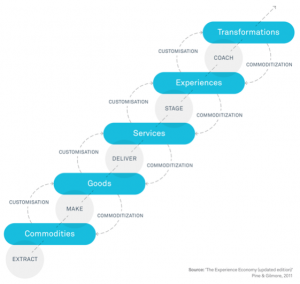Understanding the experience economy: what your customer wants
Share
Customer experiences are their own distinct type of economic offering, says Mark Cameron. In part one of this series, he outlines the importance of understanding customer wants and needs.
Over the last decade Australia really enhanced its reputation as ‘the lucky country’. While other economies were struggling with the fallout of the GFC Australia’s economy was strong. But this success has come at a cost. While many global businesses were rapidly transforming around the needs of the customer and the impacts of digital technologies, many Australian businesses were slow to react. There was no real ‘burning platform’ for change.
As a result many market commentators now say that Australian businesses are trailing the major western economies when it comes to digital proficiency. This makes Australian businesses much more susceptible to new ‘disruptive’ business models and non-traditional competitors. To deal with these perceived threats many Australian businesses have been scrambling to find a ‘silver bullet’, investing heavily in technology and data – sometimes at the expense of focusing on the overall competitive strategy.
For leaders who are looking to develop a new lens on their competitive landscape, and to discover where new opportunities may lie, investing in understanding the needs of their customers is a great place to start.
Surprisingly, many businesses think of the customer experience as a mere piece of the overall services that they offer. But in this day and age, excellent customer experiences are now their own distinct type of economic offering – and they are one of the most valuable ways for a business to cut ahead of the competition.
This concept is detailed in The Experience Economy, a book written by ex-IBMer and TED-talker Joe Pine and his co-author James Gilmore. When it was first published it broke new ground by providing any type of business with new ways to improve the experiences it provides its customers, and demonstrated how this can drive new revenue opportunities.
As a certified The Experience Economy expert, the only one in Australia in fact, I use many of the concepts, frameworks and models presented in The Experience Economy to design digital transformation programmes for our clients. In this series of articles I will discuss some of the key themes of the book and frame them up for the current digital world.
This is not a series about the common tools for understanding your customer. We won’t be discussing design thinking, journey mapping or service blueprinting, although all of those tools are very valuable. This is about looking at your whole business from the customers viewpoint and using this perspective to design new engaging, memorable experiences.
Understanding the progression of economic value
Most businesses exist in a competitive environment. As the landscape in which they operate matures, businesses need to evolve the value of their offering, or risk becoming commoditised.
The Progression of Economic value is a model created by Pine and Gilmore to help business leaders understand how offerings move up and down the value ladder.
The progression of offerings starts with commodities, the lowest-value offerings, and progresses up toward transformations, the highest value offerings. Low value offerings are material things, while the highest value offerings are intangible. The dynamic forces of an ever-evolving economy, with its continual creative destruction, continually innovates offerings.
Here are some examples of business offerings at each level of the ladder:
- A commodity business charges for undifferentiated products. e.g. iron ore,
- a goods business charges for distinctive, tangible things. e.g. a can of food,
- a service business charges for the activities performed e.g. a delivery service
- an experience business charges for the feeling customers get by engaging it. e.g. Disneyland, and
- A transformation business charges for the benefit customers receive by spending time there. e.g. a university degree.
Progressing to the next stage more or less requires giving away products at the more commodified level. For instance, to charge for a service such as new car warranties, one must be prepared to give away new cars to replace ‘lemons’. And to charge for transformations, one must be prepared to risk not being paid for the time one spends working with customers who don’t ‘transform’.
Discovering where your business’ offerings sit on the value ladder, and the upward and downward pressures on them, is a critical first step in understanding the needs of your customers and the opportunities in the market.
What follows is what you do about it and how you design experiences that change your business. This is what’s discussed in the next article in this series. The third article discusses the process of creating an exceptional customer experience.
_
Image copyright: katatonia / 123RF Stock Photo
















